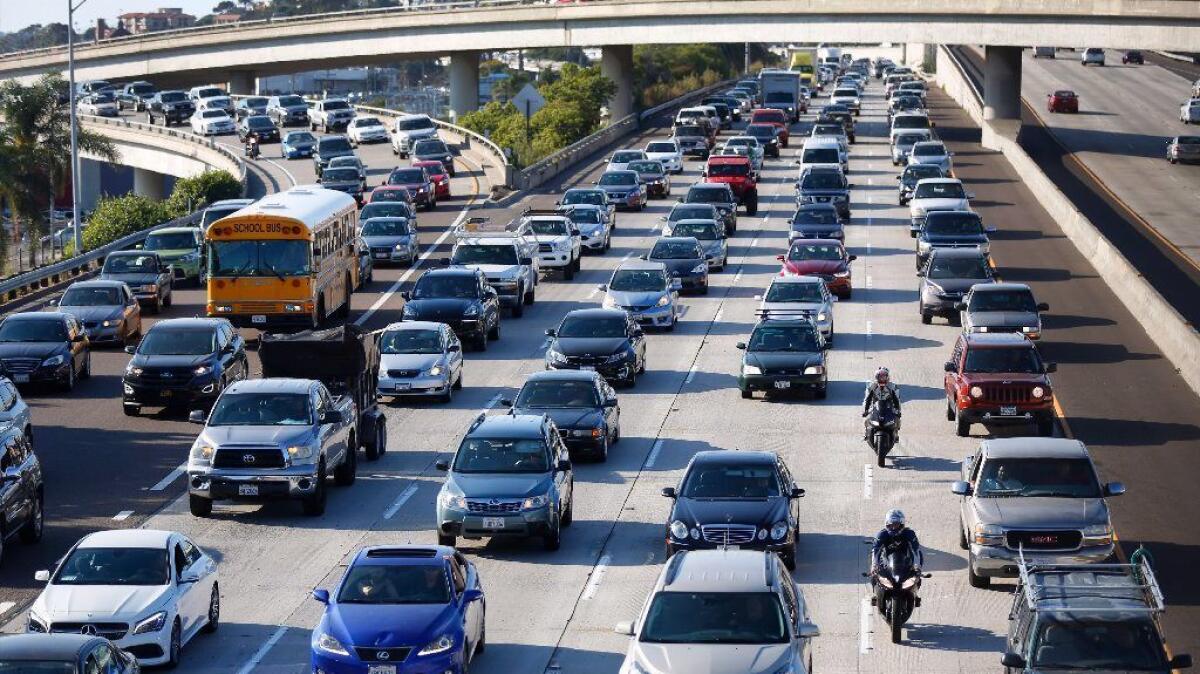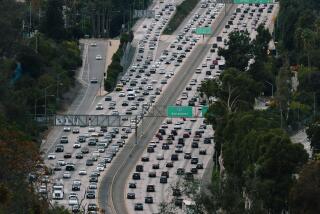As economy booms, San Diego’s traffic congestion worsens

- Share via
Reporting from San Diego — As the economy rebounds in San Diego County, so has traffic congestion.
With more people employed and the price of gas low, commute times are now at their highest since before the start of the recession.
Regional planning experts say traffic isn’t likely to get better anytime soon in San Diego or in other growing metropolitan areas across the country.
Building rail projects and clustering homes near job centers can spur economic growth while limiting the impacts to clogged freeways, according to officials. However, travel routes are in such high demand that traffic jams will be, at least for the foreseeable future, just part of the American way of life.
“If you build additional highway lanes, there’s this latent demand out there — people who would be using the highway if it were faster, if there were less congestion — so those people will come in once the highway is wider,” said Michael Anderson, a professor at UC Berkeley who studies the relationship between transit and highway systems.
Despite the growing rush-hour slog, average travel times in San Diego aren’t the worst in the nation, according to a report by the San Diego Assn. of Governments. The San Diego region ranks 19th in the nation, with an average commute about 26 minutes and an annual gross domestic product of $220 billion.
New York ranked first at more than 36 minutes and a GDP of $1.6 trillion. The Riverside-San Bernardino metropolitan area came in fourth despite its relatively small economy of $140 billion a year.
Los Angeles, known for its brutal traffic, did surprisingly well. It ranked 11th with the second largest GDP in the country, $930 billion.
“San Diego’s transitioning from being a fairly small city to becoming a much larger city,” said Mark Jacobsen, a professor at UC San Diego who studies transportation. “There will be some growing pains as we figure out how to move people around.
“If we really want to grow, the only way to do it is with density,” he added. “If the traffic really gets as bad as Riverside, that works against us to continue the growth of the city.”
Between 2008 and 2011, job losses and other economic factors led to a significant reduction in driving in San Diego County, according to the San Diego Assn. of Governments. By 2016, freeway driving had far surpassed the amount of people on the road prior to the recession a decade prior — and with it has come delays along major commuting routes.
The annual number of hours that drivers spent glued in traffic jumped from about 7.58 million in 2006 to nearly 9.9 million last year, according to data from Caltrans.
Ridership on regional buses and trolleys made significant gains during the economic downturn, with growth capping in 2015 and falling last year by about 7%.
While the Metropolitan Transit System’s local buses saw ridership decline sharply starting in 2014, its Rapid bus service has in recent years made notable gains.
The Rapid bus runs between Escondido, Rancho Bernardo, University City, UC San Diego and downtown San Diego. The service capitalizes on express lanes on Interstate 15, which serve buses, carpool and toll customers.
“Public transit does not relieve congestions, but it does move more people,” Jacobsen said. “The way to deal with increasing demand for transportation, increasing jobs and population and so on, without worsening pollution and increasing driving, is to move those people by transit.”
While rush-hour delays increased on Interstate15 as the economy recovered, those figures are still below pre-recession levels. The average travel time between Escondido and downtown was 80 minutes in 2016, down from 87 minutes in 2006.
Regional transportation officials touted their use of express lanes paired with buses as having the potential to limit freeway congestion going forward.
“It’s all these Rapids are seeing year-over-year growth, and that bucks the trend,” said Ray Traynor, department director of operations with San Diego Assn. of Governments.
Smith writes for the San Diego Union-Tribune.
More to Read
Sign up for Essential California
The most important California stories and recommendations in your inbox every morning.
You may occasionally receive promotional content from the Los Angeles Times.










